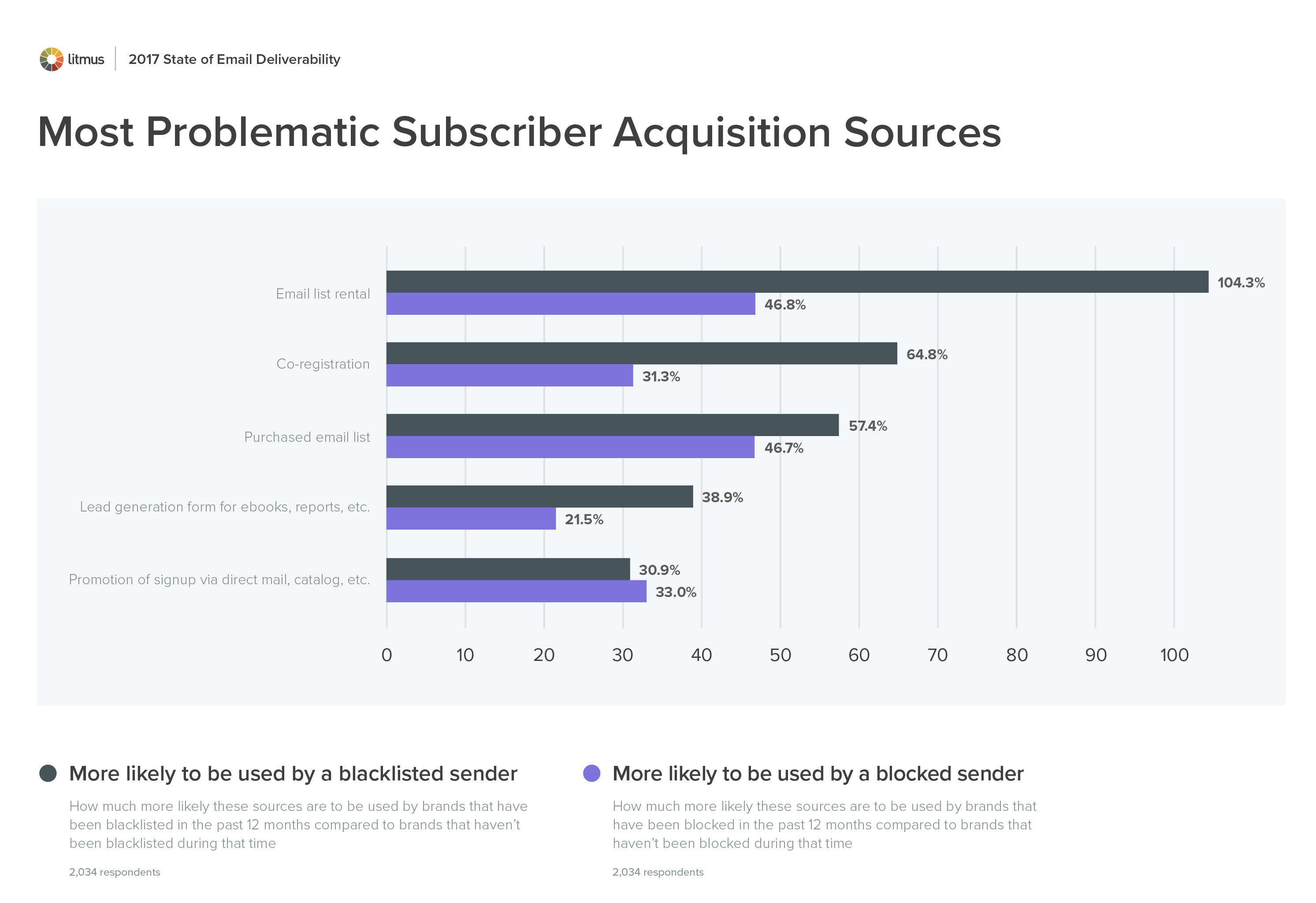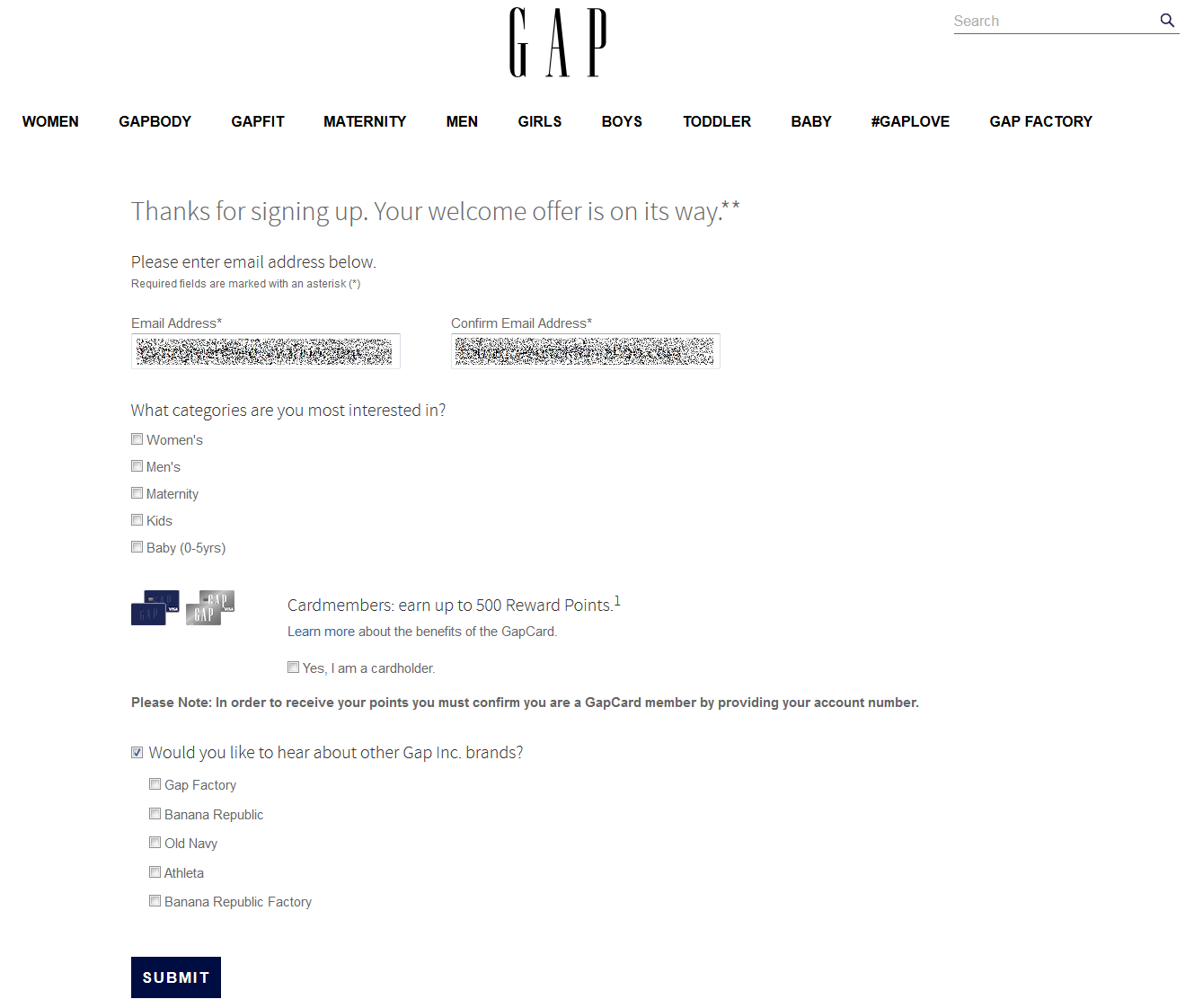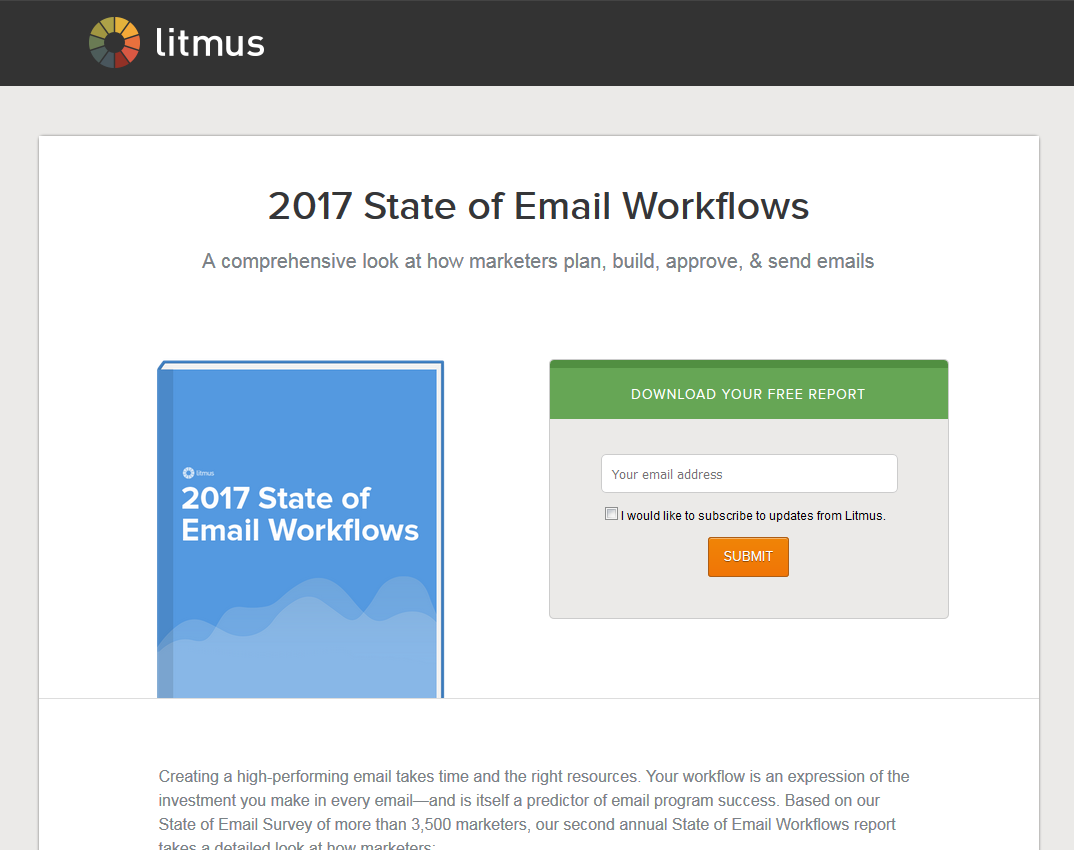Brands are always pushing to build their email lists, so they have more reach and can foster more loyalty. But not all list-building methods are created equal. While some subscriber acquisition sources are closely aligned with a brand’s operations, some are completely unassociated. Beyond brand alignment, some acquisition sources have process challenges or expectation gaps that affect the value and risks of new subscribers they attract.
In our 2017 State of Email Survey, we asked marketers about their use of 20 different subscriber acquisition sources, as well as whether their email program had been blocked or blacklisted in the past 12 months. We identified the most problematic subscriber acquisition sources by looking at which ones were used by email programs that were blocked or blacklisted and those that weren’t.
The subscriber acquisition sources at least 20% more likely to be used by blocked or blacklisted email programs include:
- Email list rental
- Co-registration
- Purchased email list
- Lead generation form for ebooks, reports, etc.
- Promotion of signup via direct mail, catalog, etc.

You likely started off reading that list nodding your head in knowing agreement, but then as you read farther down the list, you probably tilted your head in confusion. That’s because a few of these are popular, well-regarded subscriber acquisition sources. All the same, it appears that all of these are causing problems for a significant number of brands.
Let’s take a look at each in turn and see if some of them can be redeemed.
1. Email List Rental
This subscriber acquisition source being the most problematic was the first big surprise. Is this really riskier than buying a list? Actually, we don’t think so. Our conclusion is that some marketers think they’re doing list rental when they’re really not.
Here’s how I describe the email list rental process in the 3rd Edition of my book, Email Marketing Rules:
“If you rent a list from a company, you should supply the company with the message that you want sent. The list owner then sends that message on your behalf to their list—which you never see—using their usual name and email address, not yours. The unsubscribe link included in this email is an opt-out for the list owner only, not you. The list owner typically includes a tag in the subject line (e.g., A message from our friends at or [Partner offer]) and a message at the top of the email indicating that the message is from one of their partners.
This arrangement helps ensure that your message will be well received by the recipients, because the list owner would suffer unsubscribes and spam complaints if they sent a message from a partner that wasn’t a good fit for their list.”
Our guess is that some of you are saying to yourselves, Hmm, that’s not how our list rental worked. That would not be a big surprise. There’s long been confusion around list rental and—it seems to us—purposeful misuse of the term by those that are really just selling lists to make it seem legit.
Based on preliminary research we’ve done on the issue, some “list rentals” have more in common with list purchases, with the list renter getting the list of email addresses. Other “list rentals” are actually email appends, where the broker is matching email addresses up with your existing customer or prospect files that don’t have that data point. And still other “list rentals” have list owners avoiding putting their reputation on the line by using your sender name, your sender domain, and an unsubscribe link that stops recipients from hearing from you again rather than from the list owner.
Some sneaky purveyors even ask each list renter for a suppression list of people who have opted out so the list rental company can avoid sending emails to people who don’t want to hear from the buyer. The list rental company then adds the email addresses from that suppression list to their own email list, making it bigger and more valuable when they sell it to the next customer. (Some list-sellers use this same tactic, wanting to see your list so “you don’t buy email addresses you already have.”)
Done the right way, list rental can be a decent way to give your business and your email list a boost—provided the message’s call-to-action generates new leads, conversions, and subscribers. But all of the confusion and misdirection around list rental can make it risky. Picking the right partner is key—and good partners are never cheap.
2. Co-registration
Co-registration is when a company includes an email opt-in for your brand (and potentially others) on their email subscription or registration page. This arrangement leads to a few problems:
- Since this tactic is fairly uncommon, some users get confused and don’t realize that they’re signing up to receive emails from more than one company. When they start getting emails from your brand, they don’t understand why and can mark your emails as spam.
- Because the signup doesn’t happen on your website or mobile app, the person opting in may be unfamiliar with your brand or be confused about what your brand is about. That can make it difficult to meet their expectations and can easily lead to “subscriber’s remorse,” where they immediately regret opting in, resulting in unsubscribes if you’re lucky and spam complaints if you’re not.
- Because you don’t control the point of signup, you don’t have solid proof of consent. Having that can be key to resolving allegation of spamming, whether your brand is accused of breaking anti-spam laws or is trying to get off a blacklist.
Using a double opt-in process can help protect your sender reputation from some of that confusion, but we think co-registration is best used for brands that are tightly aligned. Sister brands are the ideal use case, especially when the brands use a common shopping cart and have a tabbed website so customers can easily switch between brands. The 1-800-Flowers.com family of brands and the Gap family of brands are great examples of this.

3. Purchased Email List
More than 17% of brands have purchased a list of email addresses in the past 12 months, according to our 2017 State of Email Survey. We’re not judging, but here are some reasons why this is very risky:
- You can’t buy permission. Email marketing isn’t owned media. Sure, you can buy email addresses, but it doesn’t mean you’ll be welcome in the inboxes of the email address owners. Emailing people who didn’t give you permission—and may have never heard of your brand—invites spam complaints. That easily leads to blocks and blacklistings, as our data proves.
- You risk breaking non-U.S. laws. Emailing a purchased list that hasn’t been scrupulously compiled puts you in violation of the Canadian Anti-Spam Law (CASL), the upcoming General Data Protection Regulation (GDPR), and other international spam and privacy laws. List brokers—and by extension, list buyers—have to be able to explain “how [the list] was compiled and provide full details of what individuals consented to, when and how,” according to guidance from the Information Commissioners Office (ICO). Remember: These laws are based on where the email recipient is located, not where your brand is based, so buying lists that contain non-U.S. email addresses that weren’t rigorously consented puts you at risk of substantial fines, in addition to sender reputation damage.
- You’re risking spam traps. Some list purveyors scrape email addresses off the internet, or work with others who do. In addition to email addresses listed on websites, harvesting software will also gather pristine spam traps, which are used by inbox providers and blacklisting organizations to identify spammers. Having even a few spam traps on your email list is a quick way to get blocked or blacklisted.
- You’re risking getting role-based email addresses. Sales@company.com, support@organization.org, and other similar email addresses are generally used for inbound inquiries only, not for subscribing to newsletters or promotional emails. Because of the increased risk of spam complaints, it’s recommended that you avoid emailing these kinds of addresses. Since companies commonly post them on websites, harvesting software easily picks them up, making them common stock in purchased lists.
- Your email service provider (ESP) may fire you. Most reputable ESPs have rules against their customers uploading purchased lists to their platforms. Go against this policy and you may be dropped and have to find a new ESP. If your brand develops a reputation for such abuses, it may find it difficult to get a good ESP to take it on as a customer.
In our opinion, list purchases are the riskiest subscriber acquisition source by far.
4. Lead generation form for ebooks, reports, etc.
Let’s start by recognizing that this subscriber acquisition source is used by nearly half (49.7%) of B2B brands, so this is no fringe list growth tactic. So what’s going on here?
The core problem here is that many brands are using this subscriber acquisition source only to collect passive consent. Couple that with poor expectation setting and you get a bunch of people who wanted your research or advice, but who didn’t want your emails.
There’s a spectrum here for sure. Brands most at risk use implicit consent, where people downloading the asset are opted in without notification or confirmation. You can rachet down the risk level by using a clear passive signup mechanism, such as a prominent pre-checked opt-in box with clear language.
However, even the strongest passive consent options still leave plenty of room for potential subscriber confusion and unhappiness—plus, you can run afoul of anti-spam laws if you have subscribers outside of the U.S. In Europe, for instance, email consent always has to be given actively and separately. You can’t bundle an email consent with anything else.
If you have any significant amount of non-U.S. subscribers, you should be using or migrating to an active consent process to protect your brand from legal troubles. Securing active consent involves either an active signup process, such as having an unchecked opt-in box, or an active confirmation or double opt-in process.
Here are Litmus, we have a fair number of Canadian subscribers and a lot of European subscribers. So to be in compliance with CASL and GDPR, we’ve updated our ebook download forms to include an unchecked opt-in box.

Making that change will not only ensure you comply not only get your brand into compliance with international anti-spam laws, but will also guarantee that your new subscribers actually want to receive your emails. That will boosts subscriber engagement and reduces unsubscribes and spam complaints.
5. Promotion of signup via direct mail, catalog, etc.
All in all, this is a smart tactic. It converts prospects and customers from an expensive channel to a cheaper one—or, perhaps better yet, it allows you to amplify and reinforce your direct mail efforts with emails.
We suspect that the primary problem with this subscriber acquisition source is the signup process. We advise against any kind of reply postcard or any other method that involves people handwriting their email address. Transcription accuracy is notoriously low, which leads to lots of hard bounces and opens the door to randomly hitting a spam trap.
Instead, ask the direct mail recipient to visit an email subscription webpage via a URL, to sign up for email via SMS, or to use some other method where they’re typing in their email address via a computer or device.
Are they redeemable?
After considering all of those issues, our verdict on these subscriber acquisition sources is that…
- Email list rental is redeemable if done properly, with the list owner sending your message to their subscribers.
- Co-registration is redeemable for sister brands, and to a lesser extent when brands use a double opt-in process.
- Purchased email lists are not redeemable. Don’t do it!
- Lead generation form for ebooks, reports, etc. is redeemable when active consent is required through an unchecked opt-in box or double opt-in process.
- Promotion of signup via direct mail, catalog, etc. is redeemable when signups don’t involve the transcription of handwriting.
Make it to the inbox, not the spam folderIdentify issues that might keep you from the inbox and get actionable help for how to fix them with Litmus Spam Testing. |
The info in this blog is 2+ years old and may not be updated. See something off? Let us know at hello@litmus.com.
Chad S. White is the Head of Research at Oracle Digital Experience Agency.
